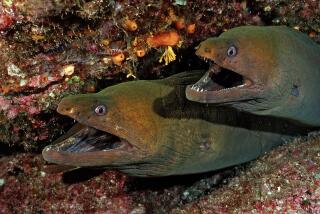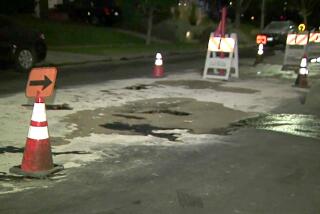Mammoth Problem at Tar Pits : Artworks: Fiberglass sculpture breaks loose from mooring in lake. Museum officials plan a rescue effort.
For the first time in more than 10,000 years, a mammoth is stuck in the La Brea tar pits.
Not a real one, silly.
The Ice Age creatures, which looked like elephants with delusions of grandeur, have been extinct for eons.
The mammoth in question is a fiberglass sculpture normally moored in the asphalt-streaked lake in front of the George C. Page Museum of La Brea Discoveries in Hancock Park.
During last month’s heavy rains, the fiberglass figure of a half-submerged female Columbian mammoth broke loose from its mooring and suffered the same fate as millions of creatures, large and small, over the last 40,000 years. It got stuck in the asphalt deposits that ooze to the surface throughout the area and make the tar pits the richest cache of Ice Age fossils in the world.
Until the fiberglass beast became mired, it was part of a mammoth family group created by sculptor Howard Ball and installed in 1968. Normally, the female figure looks toward the eastern shore of the lake, where her 10-foot-tall mate and pony-sized infant are waiting. The female has her head thrown back as if roaring a warning to her family, perhaps urging them to keep an eye peeled for saber-toothed cats.
Before it got stuck in the asphalt, the figure had shifted out of position so that now it seems to be roaring its warning at patrons of the museum’s snack stand.
According to Page museum staffers, the shift in the sculpture’s position has been noted by a number of sharp-eyed visitors. “One person came in and said, ‘Did you know your mammoth is loose?’ ” said Shelley Cox, supervisor of the museum’s laboratory.
The problem seems to be with the sculpture’s unusual mooring. The sculpture is, or was, held in place by an anchoring device that allowed the piece to rise and fall with the changing water level of the man-made lake. The staff speculates that time and exposure have taken their toll on the device. “I think with age the mooring has just deteriorated,” Cox said.
Some time next week, the sculpture will be pulled from the asphalt with a crane. “It will be the first time she’s been taken out of the water since she was put in there,” Cox said.
The figure’s condition and that of the mooring will be evaluated, and a decision will be made as to how the mammoth should be re-anchored.
Charles Fischer, who heads the habitat section of the Natural History Museum of Los Angeles County, estimated that repairs would cost only a few hundred dollars. The Page Museum is a satellite of the Natural History Museum. Scientists at the museum compare the tar pits’ asphalt to flypaper in its ability to trap anything that comes in contact with it. Thousands of years ago, dire wolves and mastodons were among the animals that got stuck. Today, the tar pits continue to be a sticky death trap. Pigeons regularly drop onto the surface of the lake and become befouled with floating asphalt. Cox speculates that the pigeons are misled by the asphalt scum on the surface into thinking it is a parking lot.
The tar pits also claim a steady stream of squirrels and other small animals.
Even humans are not immune. Excavation of the tar pits has revealed a set of fossilized human bones, believed to be the remains of a prehistoric Indian woman. But several years ago former museum staffer Eric Scott got stuck in the asphalt after he jumped a security fence to remove a traffic cone that had been thrown into one of the pits.
The worst part of the experience, Scott said, was having a park visitor walk right past, without offering to help.
“See, that’s what happened to the dumb animals,” the passerby told his young companion.
More to Read
Sign up for Essential California
The most important California stories and recommendations in your inbox every morning.
You may occasionally receive promotional content from the Los Angeles Times.










